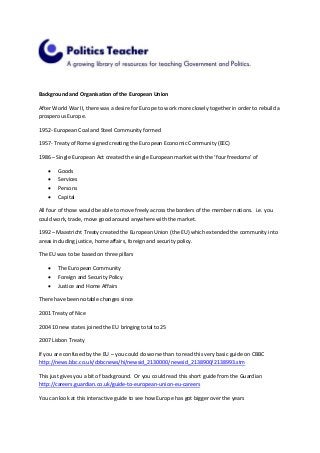
Introduction to A2: The background and organisation of the European Union
- 1. Background and Organisation of the European Union After World War II, there was a desire for Europe to work more closely together in order to rebuild a prosperous Europe. 1952- European Coal and Steel Community formed 1957- Treaty of Rome signed creating the European Economic Community (EEC) 1986 – Single European Act created the single European market with the ‘four freedoms’ of Goods Services Persons Capital All four of those would be able to move freely across the borders of the member nations. i.e. you could work, trade, move good around anywhere with the market. 1992 – Maastricht Treaty created the European Union (the EU) which extended the community into areas including justice, home affairs, foreign and security policy. The EU was to be based on three pillars The European Community Foreign and Security Policy Justice and Home Affairs There have been notable changes since 2001 Treaty of Nice 2004 10 new states joined the EU bringing total to 25 2007 Lisbon Treaty If you are confused by the EU – you could do worse than to read this very basic guide on CBBC http://news.bbc.co.uk/cbbcnews/hi/newsid_2130000/newsid_2138900/2138993.stm This just gives you a bit of background. Or you could read this short guide from the Guardian http://careers.guardian.co.uk/guide-to-european-union-eu-careers You can look at this interactive guide to see how Europe has got bigger over the years
- 2. http://www.guardian.co.uk/flash/0,5860,408196,00.html And a rather detailed timeline from the Telegraph http://www.telegraph.co.uk/news/worldnews/europe/6181087/Timeline-history-of-the-European- Union.html Watch this clip for a brief summary of how law is made in the European Union. You will also gain an outline of what each of the main institutions in the EU is i.e. The Council of the European Union The European Commission The European Parliament http://www.bbc.co.uk/learningzone/clips/how-a-law-is-made-in-the-european-union/7272.html Task: Make a poster showing the key dates in the development of the EU and the key institutions together with a brief summary of their main functions.